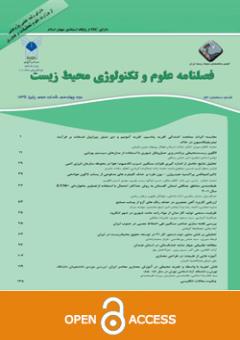بررسی اثر کاربری زمین در مقدار پتانسیل سيل خيزی مناطق شهری ( مطالعه موردی: منطقه یک شهرداری تهران)
الموضوعات :مهدیه سعادت فومنی 1 , بهرام ملک محمدی 2
1 - کارشناسی ارشد برنامهریزی محیطزیست. دانشگاه تهران. * (مسوول مکاتبات)
2 - دانشیار گروه برنامهریزی، مدیریت و آموزش محیطزیست. دانشگاه تهران.
الکلمات المفتاحية: مدیریت رواناب, سیلاب شهری, پتانسیل سیلخیزی, روش شماره منحنی, کاربری اراضی.,
ملخص المقالة :
زمینه و هدف: شهر تهران بطور پیوسته در معرض وقوع سیل قرار دارد. تراکم بالای سطوح نفوذناپذیر و حجم بالای رواناب در شهر و همچنین قرار گرفتن در پای کوه، از دلایل اصلی پتانسیل سیل در تهران محسوب میگردد. لذا شناسایی مناطق مستعد سیلاب شهری از اقدامات مهم در کاهش خسارات و مدیریت صحیح محسوب میگردد.
روش بررسی: در این پژوهش منطقه یک شهر تهران از نظر پتانسیل سیلاب شهری با استفاده از روش شماره منحنی در محیط نرمافزار ArcMap مورد بررسی قرار گرفت.
یافته ها: با تلفیق دادهها و اطلاعات نقشه شماره منحنی و نفوذ با توجه به کاربری منطقه تهیه گردید. سپس با استفاده از روابط و نقشه پهنهبندی حداکثر بارش روزانه برای دوره بازگشتهای مختلف، ارتفاع رواناب برای منطقه محاسبه شد.
بحث و نتیجه گیری: نتایج حاکی از آن است که برای بارش در دوره بازگشت 5 ساله و 10 ساله حدود 90 درصد منطقه پتانسیل سیلخیزی زیاد و خیلی زیاد دارند که این میزان در دوره بازگشتهای 25 و 50 ساله به بالای 95 درصد میرسد. همچنین در دوره بازگشتهای 25 و 50 ساله تمام منطقه پتانسیل سیلاب شهری متوسط به بالا را دارا میباشد و پهنه با پتانسیل سیلاب کم دیده نمیشود. همچنین در مناطقی که تراکم کاربریهای مسکونی و پارکینگ بیشتر است، اثر تجمعی سطوح نفوذناپذیر باعث افزایش پتانسیل سیلخیزی میگردد.
1. Novotny V. Non point Pollution and Urban Stormwater Management: CRC Press; 1995.
2. Ghanbari Adivi, M. Investigating the atmospheric performance of local gardens in Tehran in order to design for the removal of surface runoff pollutants. Master thesis of Sharif University of Technology, 2011. (In Persian)
3. Tanski J. Stormwater runoff. Best management practices for marinas. A guide for operators. 2007.
4. Vereecken H, Kemna A, Münch HM, Tillmann A, Verweerd A. Aquifer characterization by geophysical methods. Encyclopedia of Hydrological Sciences. 2005.
5. Igulu, B. S., & Mshiu, E. E. The Impact of an Urbanizing Tropical Watershed to the Surface-Runoff. Global Journal of Environmental Science and Management,2020, 6, 245-260.
6. Cao, W. T. et al. Increasing global urban exposure to flooding: An analysis of long-term annual dynamics. Sci. Total Environ. 817,10. https://doi.org/10.1016/j.scitotenv.2022.153012 (2022).
7. He, C. et al. Future global urban water scarcity and potential solutions. Nat. Commun. 12, 4667. https://doi.org/10.1038/s41467- 021-25026-3 (2021).
8. Abass, K., Adanu, S. K., & Agyemang, S. (2018). Peri-Urbanization and Loss of Arable Land in Kumasi Metropolis in Three Decades: Evidence from Remote Sensing Image Analysis. Land Use Policy, 72, 470-479. (In Persian)
9. Sillanpää N, Koivusalo H. Impacts of urban development on runoff event characteristics and unit hydrographs across warm and cold seasons in high latitudes. Journal of Hydrology. 2015;521:328-40.
10. Alshammari, E., Rahman, A. A., Rainis, R., Seri, N. A., & Fuzi, N. F. A. (2023). The Impacts of Land Use Changes in Urban Hydrology, Runoff and Flooding: A Review. Current Urban Studies, 11, 120-141.
11. Zhan X, Huang M-L. ArcCN-Runoff: an ArcGIS tool for generating curve number and runoff maps. Environmental Modelling & Software. 2004; 19(10):875-9.
12. Sarangi A, Singh D, Singh A. Evaluation of curve number and geomorphology-based models for surface runoff prediction from ungauged watersheds. Current science. 2008; 94(12):1620.
13. Gitika T, Ranjan S. Estimation of Surface Runoff using NRCS Curve number procedure in Buriganga Watershed, Assam, India-A Geospatial Approach. International research journal of earth sciences, 2 (5), 1. 2014;7.
14. Hamdami, Q. Shiday Kirkej, A. Akbari Majder, H. Preparation of curve number map of Marawa Tepe area using geographic information system. Protection and exploitation of natural resources, 1(3), 2012. (In Persian)
15. Nosrati, K. Ahmadi, M. Tharvati, M. Marzbani, M. Determining the effective factors in flood potential of Darehshahr watershed based on homogeneous hydrological areas. Geographical analysis of space, 3, 2014. (In Persian)
16. Zistab Consulting Engineers Co. Studies on the operationalization of the comprehensive plan of surface water management and the preparation of plans for the improvement of rivers and canals in one area of Tehran municipality, 2013. (In Persian)
17. Vice President of Planning and Urban Development of Tehran Municipality. Operational plan of Tehran city, 2014. (In Persian)
18. Mishra S, Tyagi J, Singh V, Singh R. SCS-CN-based modeling of sediment yield. Journal of Hydrology. 2006;324(1):301-22.
19. Kumar PS, Babu MRK, Praveen T. Analysis of the Runoff for Watershed Using SCS-CN Method and Geographic Information Systems. Analysis. 2010;2(8):3947-654.
20. Mahdavi, M. Applied Hydrology: University of Tehran, 2011. (In Persian)
21. McCuen RH. Hydrologic analysis and design: Prentice-Hall Englewood Cliffs, NJ; 1989.


